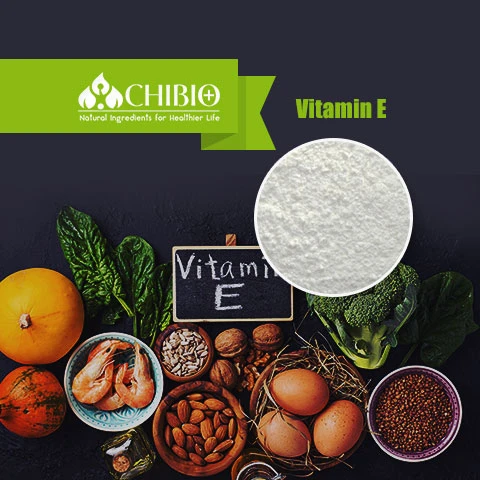Vitamin E
Product Details

1.What is Vitamin E?
Vitamin E is a fat-soluble vitamin whose hydrolysate is tocopherol and is one of the most important antioxidants. Soluble in organic solvents such as fat and ethanol, insoluble in water, stable to heat, acid, unstable to alkali, sensitive to oxygen, not sensitive to heat, but vitamin E activity is significantly reduced when fried.

The phenolic hydroxyl group on the vitamin E phenyl ring is acetylated, and the ester is hydrolyzed to a phenolic hydroxyl group to be a tocopherol. Tocopherol can promote the secretion of sex hormones, increase the vitality and quantity of men’s sperm; increase the concentration of female estrogen, improve fertility, prevent abortion, and can also be used to prevent male infertility, burns, frostbite, capillary bleeding, menopausal syndrome, Beauty and other aspects. Recently, it has also been found that vitamin E can inhibit the lipid peroxidation reaction in the lens of the eye, expand the peripheral blood vessels, improve blood circulation, and prevent the occurrence and development of myopia.

2.Types of Vitamin E
Vitamin E is an important antioxidant with 8 forms of fat-soluble vitamins. Vitamin E includes 8 kinds of tocopherols and tocotrienols, namely α, β, γ, δ tocopherol and α, β, γ, δ triene tocopherol. α-tocopherol is the most widely distributed in nature. The most abundant and active vitamin E form.
Vitamin E (α-tocopherol) Vitamin E refers to a group of compounds, the natural type is d-α-tocopheryl acetate, and the synthetic type is dl-α-tocopheryl acetate. Among various forms of VE, gamma-tocopherol is the most common. It is found in corn oil, soybean oil, butter and certain seasonings. Alpha-tocopherol is the most biologically active form of VE and the second most common form of VE in the North American diet (gamma-tocopherol first), commonly found in safflower oil, melon oil and wheat germ oil. Alpha-tocopherol is a fat-soluble antioxidant that effectively prevents the formation of active oxides during fat oxidation.
3.Specifications of Vitamin E
| Item | Standard |
| Appearance | Slightly yellow ,clear, viscous oil |
| Assay by GC | 50%-98% |
| Density | 0.952-0.966g/ml |
| Refractive index | 1.494-1.498 |
| Acidity | Max.1.0ml of 0.1 NaOH |
| Sulphated ashes | Max.0.1% |
| Yeast & molds | Not more than 100cfu/g |
| E. Coli | Negative( in 10g) |
| Salmonella | Negative (in 25g) |
| Heavy metals | Max.10 ppm |
| Arsenic | Max.3 ppm |
| Lead | Max.2 ppm |
| Free tocopherol | Max.1.0% |
COA will be offered according to the type of Vitamin E you request.
4.Benefits & Applications of Vitamin E

Vitamin E is fat-soluble, which protects the body from unsaturated fatty acids from free radicals. Unsaturated fatty acids have the function of protecting internal organs.
Vitamin E can promote reproduction. It can promote the secretion of sex hormones, increase the vitality and quantity of men’s sperm; increase the concentration of female estrogen, improve fertility and prevent abortion.
Testicular atrophy and epithelial cell degeneration occur when vitamin E is deficient, and abnormalities are caused.
Vitamin E is commonly used in the treatment of threatened abortion and habitual abortion. In addition, it also helps to prevent male infertility.

- Health Pharmaceuticals Industry:
Vitamin E is a very important vasodilator and anticoagulant; prevent and treat varicose veins; prevent blood coagulation and reduce the formation of streak tissue.
Strengthens the liver cell membrane, protects alveolar cells, and reduces the risk of infection in the lungs and respiratory system.
Prevent cancer, effectively inhibit tumor growth; prevent multiple chronic diseases; prevent inflammatory skin diseases, alopecia; prevent hemolytic anemia, protect red blood cells from rupture; prevent and treat thyroid diseases; improve blood circulation, protect tissues, lower cholesterol And prevent high blood pressure.

- Cosmetics Industry:
Delay aging, effectively reduce the production of wrinkles and maintain the appearance of youth.
Reduces the amount of oxygen consumed by the cells, making people more durable, helping to reduce leg cramps and stiff hands and feet.Protects skin from UV rays and pollution, reduces the deposition of scars and pigments, and accelerates wound healing.
Antioxidant protects cells from free radicals.Moisturizing skin: Vitamin E is found in many moisturizers, and the oil may be used as a moisturizer to prevent or treat dry, flaking skin.

- Feed Industry:
Vitamin E, known as all – rac -α-tocopheryl acetate in commercial form as animal feed supplementation, is present in natural form in the lipid fraction of feed ingredients, albeit susceptible to oxidation. Vitamin E cannot be synthesised by poultry and pigs and thus must be included in the diet.

It helps to maintain the structural integrity of tissues, to develop the nervous system, and substantially contributes to disease resistance of animals due to its modulating effects on the immune system. Vitamin E is actively absorbed in the gut. Vitamin E is packaged into lipid-bile micelles and is transported via the lymphatic pathway to the liver, then with a specific transport-protein into the blood circulation.






